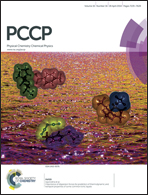Infrared spectroscopy of large-sized neutral and protonated ammonia clusters†
Abstract
Size-selective infrared spectroscopy was applied to neutral and protonated ammonia clusters, (NH3)n (n = ∼5–∼80) and H+(NH3)n (n = 8–100), to observe their NH stretching vibrations. The moderate size selection was achieved for the neutral clusters by the infrared–ultraviolet double resonance scheme combined with mass spectrometry. The size dependence of the observed spectra of (NH3)n is similar to that of the average size-controlled clusters doped in He droplets. The ν1 (NH sym stretch)/ν3 (NH asym stretch) band intensity ratio shows a rapid decrease in the size range n ≤ ∼20. This demonstrates that ammonia begins to form crystalline like hydrogen bond networks at the much smaller size region than water. The precise size selection was achieved for H+(NH3)n by infrared photodissociation spectroscopy combined with a tandem type quadrupole mass spectrometer. The spectra of the protonated clusters become almost identical with those of the corresponding neutral clusters at n ≥ ∼40, demonstrating that the radial chain structures, which are characteristic of the small-sized protonated clusters, develop into the crystalline like structures seen in the neutral clusters up to n = ∼40.


 Please wait while we load your content...
Please wait while we load your content...